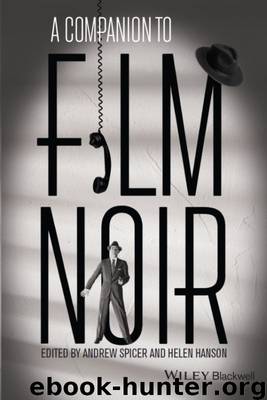A Companion to Film Noir by Andrew Spicer

Author:Andrew Spicer
Language: eng
Format: epub
Publisher: John Wiley & Sons
Published: 2013-06-26T16:00:00+00:00
Gilda: Object of Contemplation, Desiring Subject, Woman being Beaten
A woman in an evening gown flirting with the viewer is a classic pose in Hollywood poster and newspaper publicity, yet Gilda’s poster has fascinated film culture for decades. Melvyn Stokes details a wide range of “international cultural productions” that evoke Gilda as an homage to classic Hollywood cinema, including Ladri di biciclette (Bicycle Thieves, Vittorio De Sica, 1948), Beltenebros (Pilar Miro, 1991) MadreGilda (Francisco Requiero, 1993), Shawshank Redemption (Frank Darabont, 1994), Frasier (NBC, 1993–2004), and Mulholland Dr. (David Lynch, 2001).7 The poster itself is highly sought after by collectors, Ira Resnick relates its high auction price at Christie’s sale of vintage movie posters.8
Martin Scorsese explains why this ephemeral poster might have acquired a high material value, arguing that it is “one of the most iconic images in American movies . . . It suggests a kind of enchanted celestial life far above us.”9 Eddie Muller argues that film noir presented poster designers with a tantalizing challenge, and he singles out Gilda as follows:
Posters [sic] artists the world over avidly took up the challenge of rendering this provocative new image of female sexuality. Typically, these posters presented women fully aware of the mesmerizing power they possessed. They offered an insolent gaze, aimed either directly at the viewer or downward, toward the credulous man entangled in their web. Most renowned among femmes fatales is Gilda, the character that made an international sensation of Rita Hayworth.10
The image of Hayworth as Gilda dressed in the Jean Louis strapless satin gown dominates the Gilda pressbook and poster publicity and the film’s place in history: the whiteness of her bare arms, her full red hair falling gently to bare white shoulders, the insouciant smile, the fabric of the dress crisscrossing her breasts, the wrap she drags along the floor with her right hand, the cigarette smoldering in her left hand. She is caught in mid-step, gliding toward the viewer. Her gaze, slightly off-center, does not directly address the viewer but looks at something off-frame.
The Gilda pressbook offers poster options to the exhibitor: posters with variations on this visual theme, taglines and images that suggest the dangers of Gilda’s willing sensuality. French and Italian posters offer a more sexual interpretation of Hayworth as Gilda. These posters maintain the centrality of Hayworth as Gilda to the film’s campaign, but reorient her relationship to the poster viewer through her willing pin-up posture and gaze.
The central image for the Gilda campaign, described above, is the woman in a strapless gown with flowing hair, a woman active in her display. Modifications of this visual theme are the color of the dress, the position of the body, the presence or absence of sensual cigarette smoke and fur wrap. On the front cover of the pressbook, the studio speaks the tag line “There NEVER was a woman like GILDA!” On the back cover, Gilda speaks her shame: “now they all know what I am . . .” Here, she wears the gown in black.
Download
This site does not store any files on its server. We only index and link to content provided by other sites. Please contact the content providers to delete copyright contents if any and email us, we'll remove relevant links or contents immediately.
The Kite Runner by Khaled Hosseini(5088)
Gerald's Game by Stephen King(4584)
Dialogue by Robert McKee(4326)
The Perils of Being Moderately Famous by Soha Ali Khan(4171)
The 101 Dalmatians by Dodie Smith(3455)
Story: Substance, Structure, Style and the Principles of Screenwriting by Robert McKee(3399)
The Pixar Touch by David A. Price(3369)
Confessions of a Video Vixen by Karrine Steffans(3247)
How Music Works by David Byrne(3191)
Fantastic Beasts: The Crimes of Grindelwald by J. K. Rowling(2997)
Harry Potter 4 - Harry Potter and The Goblet of Fire by J.K.Rowling(2996)
Slugfest by Reed Tucker(2946)
The Mental Game of Writing: How to Overcome Obstacles, Stay Creative and Productive, and Free Your Mind for Success by James Scott Bell(2847)
4 - Harry Potter and the Goblet of Fire by J.K. Rowling(2657)
Screenplay: The Foundations of Screenwriting by Syd Field(2576)
The Complete H. P. Lovecraft Reader by H.P. Lovecraft(2514)
Scandals of Classic Hollywood: Sex, Deviance, and Drama from the Golden Age of American Cinema by Anne Helen Petersen(2467)
Wildflower by Drew Barrymore(2447)
Robin by Dave Itzkoff(2387)
